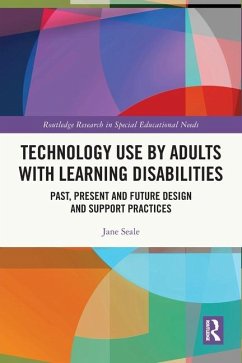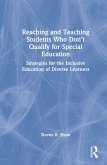Jane Seale
Technology Use by Adults with Learning Disabilities
Past, Present and Future Design and Support Practices
Jane Seale
Technology Use by Adults with Learning Disabilities
Past, Present and Future Design and Support Practices
- Broschiertes Buch
- Merkliste
- Auf die Merkliste
- Bewerten Bewerten
- Teilen
- Produkt teilen
- Produkterinnerung
- Produkterinnerung
This book examines the role that technologies play in the lives of adults with learning disabilities. It analyses how design and support practices can be used to support access to technology in ways that can enhance opportunities and life experiences.
Andere Kunden interessierten sich auch für
![Disability Studies and the Inclusive Classroom Disability Studies and the Inclusive Classroom]() Susan BaglieriDisability Studies and the Inclusive Classroom148,99 €
Susan BaglieriDisability Studies and the Inclusive Classroom148,99 €![Reaching and Teaching Students Who Don't Qualify for Special Education Reaching and Teaching Students Who Don't Qualify for Special Education]() Steven R. ShawReaching and Teaching Students Who Don't Qualify for Special Education168,99 €
Steven R. ShawReaching and Teaching Students Who Don't Qualify for Special Education168,99 €![Inclusive and Adaptive Teaching Inclusive and Adaptive Teaching]() Peter WestwoodInclusive and Adaptive Teaching167,99 €
Peter WestwoodInclusive and Adaptive Teaching167,99 €![Addressing Tensions and Dilemmas in Inclusive Education Addressing Tensions and Dilemmas in Inclusive Education]() Brahm NorwichAddressing Tensions and Dilemmas in Inclusive Education171,99 €
Brahm NorwichAddressing Tensions and Dilemmas in Inclusive Education171,99 €![Art Therapy with Special Education Students Art Therapy with Special Education Students]() Dafna RegevArt Therapy with Special Education Students32,99 €
Dafna RegevArt Therapy with Special Education Students32,99 €![Advancing Adaptive Education Advancing Adaptive Education]() Advancing Adaptive Education150,99 €
Advancing Adaptive Education150,99 €![Inclusive Education in China Inclusive Education in China]() Wangqian FuInclusive Education in China54,99 €
Wangqian FuInclusive Education in China54,99 €-
-
-
This book examines the role that technologies play in the lives of adults with learning disabilities. It analyses how design and support practices can be used to support access to technology in ways that can enhance opportunities and life experiences.
Produktdetails
- Produktdetails
- Verlag: Routledge
- Seitenzahl: 236
- Erscheinungstermin: 29. Januar 2024
- Englisch
- Abmessung: 234mm x 156mm x 13mm
- Gewicht: 365g
- ISBN-13: 9780367753580
- ISBN-10: 0367753588
- Artikelnr.: 69921905
- Herstellerkennzeichnung
- Libri GmbH
- Europaallee 1
- 36244 Bad Hersfeld
- gpsr@libri.de
- Verlag: Routledge
- Seitenzahl: 236
- Erscheinungstermin: 29. Januar 2024
- Englisch
- Abmessung: 234mm x 156mm x 13mm
- Gewicht: 365g
- ISBN-13: 9780367753580
- ISBN-10: 0367753588
- Artikelnr.: 69921905
- Herstellerkennzeichnung
- Libri GmbH
- Europaallee 1
- 36244 Bad Hersfeld
- gpsr@libri.de
Jane Seale is a Professor of Education at the Open University in the UK. Her research interests lie at the intersections between disability, technology and inclusion. One particular focus of her work is the development and evaluation of methods that promote voice and empowerment for adults with learning disabilities.
1. Taking stock of past and present practice. 2. A framework for examining
how adults with learning disabilities are supported to use technologies. 3.
Exploring narratives of potential: From the perspective of adults with
learning disabilities. 4. Technologies of the past: Mixed blessings. 5.
Building networks and creating gaps: Past policy initiatives. 6. Support
networks of the past: A constellation of communities of practice. 7.
Mapping the characteristics of past support practice. 8. Technologies of
the present: New design imperatives. 9. Navigating the causes of digital
inequalities: Present policy and legislative initiatives. 10. Support
networks of the present: A conflict of enterprises? 11. Mapping
characteristics of present support practice. 12. Charting a course to a
future practice
how adults with learning disabilities are supported to use technologies. 3.
Exploring narratives of potential: From the perspective of adults with
learning disabilities. 4. Technologies of the past: Mixed blessings. 5.
Building networks and creating gaps: Past policy initiatives. 6. Support
networks of the past: A constellation of communities of practice. 7.
Mapping the characteristics of past support practice. 8. Technologies of
the present: New design imperatives. 9. Navigating the causes of digital
inequalities: Present policy and legislative initiatives. 10. Support
networks of the present: A conflict of enterprises? 11. Mapping
characteristics of present support practice. 12. Charting a course to a
future practice
1. Taking stock of past and present practice. 2. A framework for examining how adults with learning disabilities are supported to use technologies. 3. Exploring narratives of potential: From the perspective of adults with learning disabilities. 4. Technologies of the past: Mixed blessings. 5. Building networks and creating gaps: Past policy initiatives. 6. Support networks of the past: A constellation of communities of practice. 7. Mapping the characteristics of past support practice. 8. Technologies of the present: New design imperatives. 9. Navigating the causes of digital inequalities: Present policy and legislative initiatives. 10. Support networks of the present: A conflict of enterprises? 11. Mapping characteristics of present support practice. 12. Charting a course to a future practice
1. Taking stock of past and present practice. 2. A framework for examining
how adults with learning disabilities are supported to use technologies. 3.
Exploring narratives of potential: From the perspective of adults with
learning disabilities. 4. Technologies of the past: Mixed blessings. 5.
Building networks and creating gaps: Past policy initiatives. 6. Support
networks of the past: A constellation of communities of practice. 7.
Mapping the characteristics of past support practice. 8. Technologies of
the present: New design imperatives. 9. Navigating the causes of digital
inequalities: Present policy and legislative initiatives. 10. Support
networks of the present: A conflict of enterprises? 11. Mapping
characteristics of present support practice. 12. Charting a course to a
future practice
how adults with learning disabilities are supported to use technologies. 3.
Exploring narratives of potential: From the perspective of adults with
learning disabilities. 4. Technologies of the past: Mixed blessings. 5.
Building networks and creating gaps: Past policy initiatives. 6. Support
networks of the past: A constellation of communities of practice. 7.
Mapping the characteristics of past support practice. 8. Technologies of
the present: New design imperatives. 9. Navigating the causes of digital
inequalities: Present policy and legislative initiatives. 10. Support
networks of the present: A conflict of enterprises? 11. Mapping
characteristics of present support practice. 12. Charting a course to a
future practice
1. Taking stock of past and present practice. 2. A framework for examining how adults with learning disabilities are supported to use technologies. 3. Exploring narratives of potential: From the perspective of adults with learning disabilities. 4. Technologies of the past: Mixed blessings. 5. Building networks and creating gaps: Past policy initiatives. 6. Support networks of the past: A constellation of communities of practice. 7. Mapping the characteristics of past support practice. 8. Technologies of the present: New design imperatives. 9. Navigating the causes of digital inequalities: Present policy and legislative initiatives. 10. Support networks of the present: A conflict of enterprises? 11. Mapping characteristics of present support practice. 12. Charting a course to a future practice









